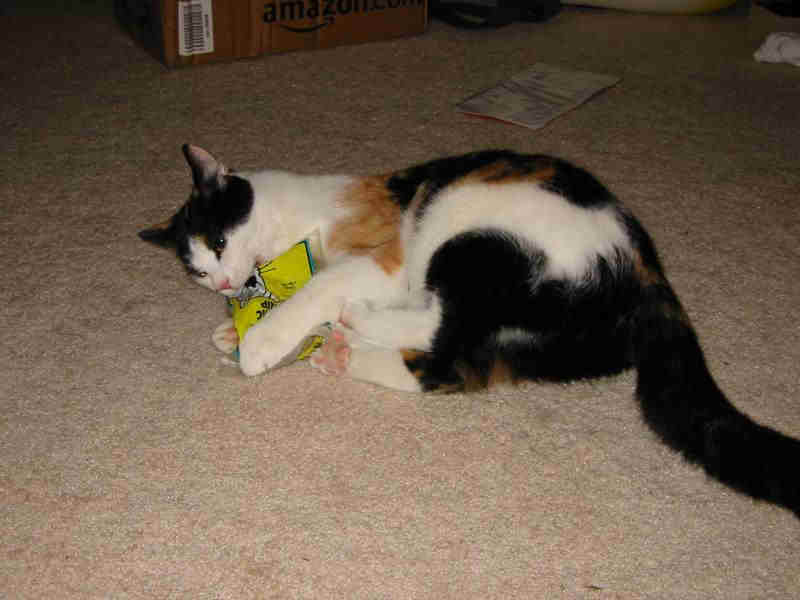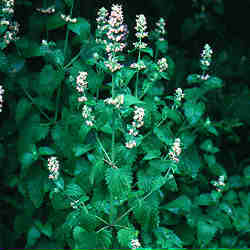Research is discovering
Catnip is Comforting to
Cats who are ill
|
|
Please Help Pets with a Small Donation of One Dollar
Catnip
Scientifically known as Nepeta cataria, catnip is a perennial
herb native to Eurasia. Although some people consider
it a weedy pest, it is now cultivated worldwide as an
ornamental. It has also been grown as a medicinal plant
and a food source.
Catnip (Nepatia cataria) is also a plant native to North America .
Fresh leaves of the catnip plant have a mint-like scent, while
dried leaves smell like alfalfa.
In all members of the cat family, contact with catnip causes
a peculiar reaction called the catnip response.
Even scientists don't fully understand why felines respond to
catnip the way they do. They do know, however, that this
inherited reaction is induced by a chemical in the herb called
nepetalactone, it is chemically similar to hallucinogens.
Kittens are largely unaffected by catnip, and even those who
are genetically predisposed won't feel a real thrill until they're
at least six to eight weeks of age. Older cats seem to be
less sensitive to the herb as well. But best of all, this terrific
treat is not toxic and its effects will not harm your pet.
The catnip response includes initial investigation, oral contact,
grasping and kicking, and abandonment. It lasts an average of
about 6 minutes but is most intense for 2-3 minutes. Male and
female cats of reproductive age are more sensitive to catnip
than very young or old cats.
Picture of Cat Playing with Catnip

(photo compliments of www.mandrake.net)
It is not just domesticated cats who find catnip irresistible,
but also 80 to 90% of other members of the cat family,
including lions, pumas, and leopards.
Studies of cat response to catnip indicate that their reactions
are inherited–either they love it or they ignore it, based
on genetic information rather than learned behavior.
Research also suggests that nepetalactone mimics a pheromone
that is found in the urine of male cats and associated with
courtship behavior. This may be why cats are so attracted
to the herb.
Cat owners derive great pleasure from the apparent enjoyment
of their pets. Some cats are eager when catnip is offered and
seem to revel in its effects, while other cats appear to avoid it,
despite prior displays of catnip sensitivity.
The behavior pattern associated with catnip may be more
closely related to predatory behavior. A cat’s reaction to
the detection and capture of prey parallels many of the phases
of the catnip response. Pawing and marking, clasping and
rolling onto the side, and rhythmic kicking with the back
feet are common to hunting behavior and the catnip response.
If your kitty goes kooky for catnip, you're in luck. There's a
wide variety of catnip products out there. Catnip mice and
other catnip-stuffed toys are classic feline favorites, and can
be a fun and effective part of a program to keep more
sedentary pets active and exercised. Do take care to
avoid toys with bells or other small parts that Fluffy could
accidentally swallow or choke on.
Catnip may be grown in indoor gardens, providing a fresh
supply and to distract cats from chewing ornamental houseplants.
Catnip is also gaining recognition for its usefulness in comforting
cats who have undergone surgery. Veterinary offices can
lessen anxiety in the recovery room by sprinkling some fresh
catnip on the floor two or three times a day. This herbal
therapy can be continued when the feline patient returns home.
Catnip can also come in handy should your family move to
a new home - an event that's quite stressful for pets. Bring
the cat with you to your new house before the furniture arrives.
Lay a trail of catnip from one room to the next, and let
your pet follow it as she explores.
Picture of Catnip Plant

A hot infusion of catnip can promote sweating and is often
used to treat colds, flu, and fevers. Catnip is also said to
soothe the nervous system and calm the stomach, aiding
both diarrhea and colic. It has been used as a folk remedy
for colds. It has also been grown for centuries in France
where the leaves and shoots have traditionally been used
to flavor foods. Most recently, researchers at Iowa State
University may have found yet another use for this member
of the mint family–as an insect repellent.
Pregnant women should not use catnip. May also cause increased
menstrual flow.
Types of Catnip
COMMON NAME: Catnip
SCIENTIFIC NAME: Nepeta Cataria
FAMILY: Labiatae
DESCRIPTION: Perennial Tall, erect growth up to 3 feet.
Flowers are white spikes on at the ends of each branch
COMMON NAME: Lemon Catnip
SCIENTIFIC NAME: Nepeta Cataria Citriodorata
FAMILY: Labiatae
DESCRIPTION: Perennial. Same as regular catnip above only with a lemon scent.
COMMON NAME: Camphor Catnip
SCIENTIFIC NAME: Nepeta Camphorata
FAMILY: Labiatae
DESCRIPTION: Perennial. Low growing up to 18 inches.
Flowers are white with purple dots. Camphor scented
COMMON NAME: Greek Catnip
SCIENTIFIC NAME: Nepeta Parnassica
FAMILY: Labiatae
DESCRIPTION: Perennial. Low growing and more compact
up to 18 inches. Leaves are a bit sweeter than other varieties.
Flowers are white to pale pink and sometimes blue.
COMMON NAME: Catmint
SCIENTIFIC NAME: Nepeta mussinii - Image
FAMILY: Labiatae
DESCRIPTION: Perennial. Low growing up to 12 - 14 inches.
Flowers are brilliant purple/blue and leaves a gray green. Mint scented.
|